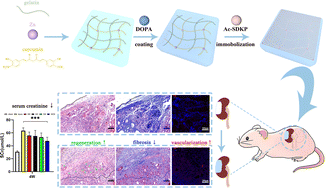A biomimetic double network hydrogel ameliorates renal fibrosis and promotes renal regeneration†
Abstract
Acute kidney injury (AKI) and chronic kidney disease (CKD) are serious global public health issues. Both interconnect closely, and AKI–CKD transition significantly increases the morbidity of CKD and inevitably progresses to end stage renal disease. However, with the current drug delivery system it is hard to achieve precise delivery and apply it to clinical practice due to the local fibrotic milieu of the AKI–CKD transition procedure. Consequently, new treatment options to halt or even reverse AKI–CKD transition are urgently needed. Curcumin and Ac-SDKP were proved to be capable of ameliorating renal injury and restoring renal biological function. However, due to the water-insolubility, poor absorption and ease of degradation features, their utilization based on traditional drug delivery systems was still confined to the laboratory. A new approach for the targeted delivery of curcumin and Ac-SDKP into kidneys is needed. Hydrogels, owing to their capability of targeted-drug delivery and bio-favorable nature, emerge as a promising resolution. Herein, we developed a bioinspired double network hydrogel scaffold loaded with curcumin and N-acetyl-seryl-aspartyl-lysyl-proline (Ac-SDKP) to explore the feasibility of drug-loaded hydrogels for treatment of AKI–CKD transition. This double network hydrogel (GCS) was prepared based on gelatin and curcumin–zinc with polydopamine (DOPA) coating and then immobilized with Ac-SDKP on the surface. The prepared hydrogels possessed appropriate porosity, suitable mechanical properties, and excellent biocompatibility. In vitro, the GCS hydrogel was demonstrated to be pro-angiogenic, anti-oxidative and anti-fibrotic. In vivo, after the GCS hydrogel was implanted into partially nephrectomized rat kidneys, local renal fibrosis was observed to be improved significantly, and neo-blood vessels and neonatal renal tubules appeared around the implanted area. We speculated that the GCS hydrogel could ameliorate renal fibrosis and injury significantly and stimulate regeneration in situ. Taken together, this study demonstrated the promising potential of this bioinspired hydrogel scaffold for renal injury repair and renal regeneration.

- This article is part of the themed collection: Journal of Materials Chemistry B HOT Papers


 Please wait while we load your content...
Please wait while we load your content...